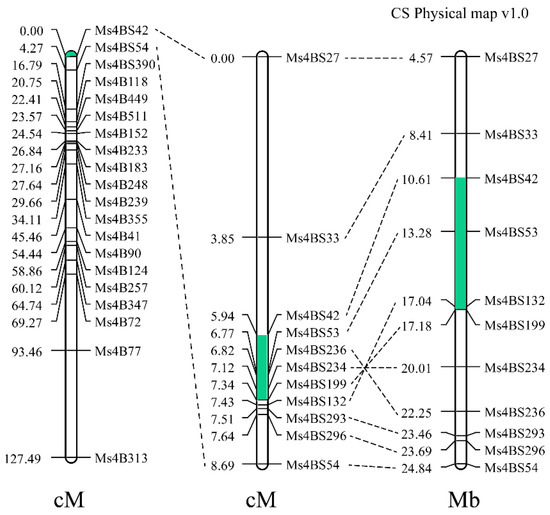As a major food crop, common wheat (
Triticum aestivum L., AABBDD) plays a vital role in ensuring the food security of human beings. Development of wheat semi-dwarf varieties during the 1950s and 1960s improved lodging resistance and permitted significant increases in yield that led to a stable global food supply and eliminated the threat of hunger. These events became known as the “Green Revolution”. However, with arable land currently decreasing due to urbanization, environmental degradation, and rising population levels, there is an emerging need to further increase wheat yield. Heterosis, a common biological phenomenon widely used in maize (
Zea mays L.) and rice (
Oryza Sativa L.), offers a way to increase wheat yield
[1][2][1,2]. Despite decades of research, the use of male sterility for the production of hybrid wheat has achieved only limited success. Wilson and Ross (1962) introduced the nucleus of common wheat into the cytoplasm of
Triticum timopheevii to develop a common wheat T-type male-sterile line, and fertility restorer lines (T-type restorer lines) were obtained by breeding and selection
[3]. Thus, a three-parent hybrid system was devised. Subsequently, new types of sterility systems, e.g., K- and V-type cytoplasmic male sterility systems, a photo-thermal sterility system, and chemical male sterilizing agents were described. However, critical biological and economic problems hindered each system, and hybrid wheat as a commercial enterprise never exceeded 0.2% of the total production
[4][5][4,5].
In 1931, Bovicini first discovered the phenomenon of nuclear male sterile in wheat, and, to date, five nuclear male sterility loci have been identified, i.e.,
Ms1,
Ms2,
Ms3,
Ms4, and
Ms5 [6][7][8][9][10][6,7,8,9,10]. Sterility alleles
ms1 and
ms5 are recessive and located on chromosome 4BS and 3AL, respectively
[11][12][11,12], whereas
Ms2,
Ms3, and
Ms4 are dominant.
Ms2 and
Ms4 are located on chromosomes 4DS, whereas
Ms3 is on chromosome 5AS
[7][8][10][13][14][7,8,10,13,14]. Many sterile alleles of the
Ms1 gene have been described. These presumably arose as natural mutants, such as Pugsley’s male sterile (
ms1a,
[6][15][6,15]) and LZ (
ms1g,
[16]); as X-ray-induced mutants, such as Probus male sterile (
ms1b,
[17]) and Cornerstone (
ms1c,
[18]); or as EMS induced mutants, including FS2 (
ms1d), FS3 (
ms1e), and FS24 (
ms1f)
[10][11][10,11]. Recently, 12 isomorphic variants of
Ms1 gene, i.e.,
ms1d.1,
ms1d.2,
ms1h,
ms1i,
ms1j,
ms1k,
ms1l,
ms1m,
ms1n,
ms1o, ms1p, and
ms1q, from the spring wheat variety Ningchun 4 were identified following EMS treatment
[19]. Many scientists believe that nuclear male-sterile lines are ideal lines for the production of hybrid varieties, but a lack of stable male-sterile maintainers prohibits their widespread application. Although a “two-line system”
[20] and an “XYZ hybrid” system using the nuclear male-sterile mutant “Cornerstone” were proposed, neither proved successful
[21][22][21,22]. Huang et al. (1988, 1991) discovered a nuclear male-sterile mutant in the offspring of a cross of wheat varieties 72,180 and Xiaoyan 6 and created a blue-aleurone nuclear male-sterile maintainer system (BM system) by introducing a 4E chromosome from
Agropyron elongatum containing a dominant blue endosperm gene and a fertility restorer gene
[23][24][23,24]. The seeds of the wheat 4E monomer alien addition line are light blue. This line can produce seeds normally by selfing, and the offspring can separate about 64% non-blue seeds (nuclear male sterile), 16% light blue seeds, 16% medium blue seeds, and 4% deep blue seeds (fertile). All plants grown from non-blue seeds were male sterile, whose fertility could be restored well in F
1 by almost any variety of bread wheat. The light blue seed is used as a maintainer for male sterility. Zhou et al. (2006) also introduced the same 4E chromosome into Lanzhou Mutant 257A (
ms1g) and established a recessive nuclear male-sterile 4E-ms system
[25]. This solved the difficulties in obtaining stable maintainer lines and producing homozygous male-sterile seeds in large quantities. It was a significant step forward in the applied research of wheat nuclear male sterility.

